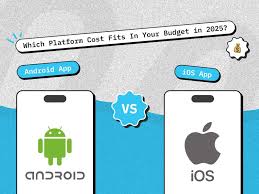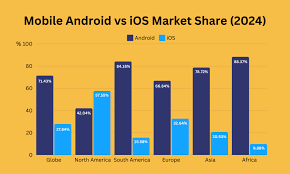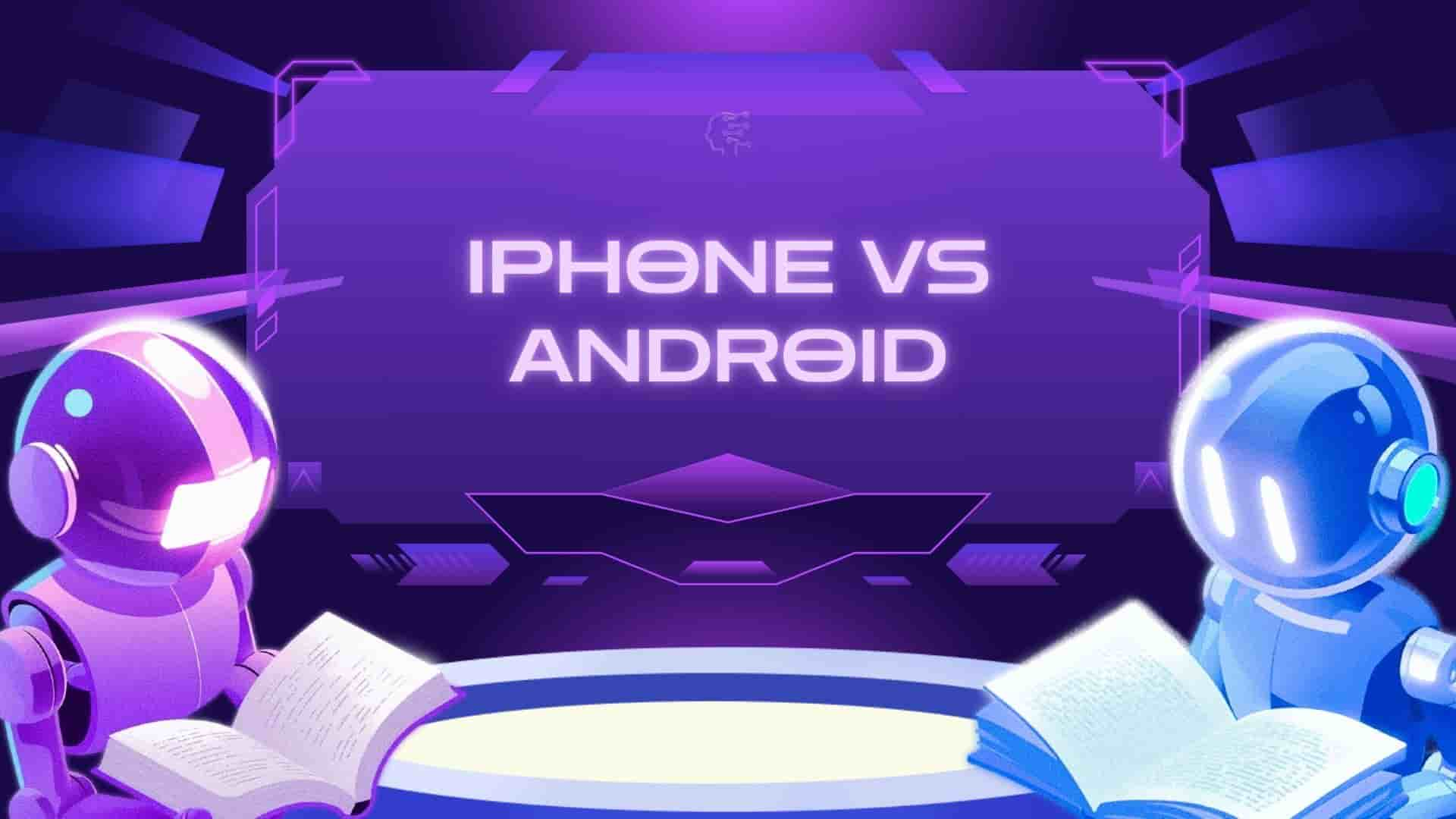Introduction
Ever found yourself staring at a wall of smartphones, caught in the epic iPhone vs Android showdown, wondering which one deserves your hard-earned cash? You’re not alone. A 2024 Statista survey revealed that 87% of smartphone buyers feel paralyzed by this choice, and in 2025, the stakes are sky-high with dazzling tech and designs that make your wallet quiver.
Should you pick Apple’s sleek, user-friendly iPhone vs Android’s customizable, budget-friendly chaos? From teens chasing TikTok fame to retirees mastering FaceTime, this 4000-word guide dives deep into the iPhone vs Android debate with humor, clarity, and practical tips. We’ll compare features, debunk myths, and help you choose the phone that fits your vibe and budget in 2025. Ready to settle this tech tug-of-war? Let’s jump in!
Understanding iPhone in 2025
The iPhone in 2025 is Apple’s crown jewel, blending cutting-edge hardware, intuitive software, and a premium aesthetic that screams sophistication. It’s the go-to for those who crave simplicity, reliability, and a touch of status.
Core iPhone Features
The iPhone 17 series (expected in 2025) brings a powerhouse of features:
-
A19 Bionic Chip: Blazing-fast for gaming, video editing, and multitasking.
-
Camera System: 48MP AI-enhanced lenses with 8K video and night mode mastery.
-
Dynamic Island: A slick hub for notifications, music, and app controls.
-
iOS 19: Smooth, privacy-focused, with new customization options.

Why Choose iPhone?
iPhone is a favorite for those who value:
-
Consistency: Flawless performance across all models.
-
Ecosystem: Seamless integration with Mac, iPad, Apple Watch, and AirPods.
-
Privacy: App Tracking Transparency and end-to-end encryption.
-
Resale Value: Holds value better than most competitors, often retaining 60% after two years.
Read more: Top 10 Hidden Android Features You Didn’t Know About
The iOS Ecosystem
Apple’s iOS ecosystem is like a cozy, gated community where everything just works. AirDrop shares files instantly, iCloud syncs your data, and Continuity lets you answer calls on your Mac. It’s user-friendly but keeps you tethered to Apple’s world—freedom comes at a cost.
iPhone’s Design Philosophy
Apple obsesses over design, crafting iPhones with premium materials like aerospace-grade aluminum and Ceramic Shield glass. The minimalist aesthetic, paired with ergonomic curves, feels luxurious. It’s not just a phone; it’s a status symbol.
Understanding Android in 2025
Android in 2025 is Google’s open-source powerhouse, running on devices from Samsung, Google, Xiaomi, OnePlus, and more. It’s the wild, versatile counterpart to iPhone, offering endless variety for every budget and taste.
Key Android Features
Top Android devices like the Samsung Galaxy S25 or Google Pixel 10 shine with:
-
Diverse Hardware: From foldables to budget phones with massive screens.
-
AI Integration: Google’s Gemini AI powers smarter assistants and apps.
-
Cameras: Multi-lens systems with AI-enhanced photo and video quality.
-
Android 16: Open-source, customizable, and packed with new features.
Why Choose Android?
Android appeals to those who want:
-
Variety: Devices from $200 budget phones to $1,500 flagships.
-
Customization: Widgets, launchers, and total home screen control.
-
Innovation: Foldables, under-display cameras, and experimental designs.
-
Affordability: High-end features at lower price points.
Check out our Android device roundup.
The Android Ecosystem
Android’s ecosystem is a vibrant, sometimes chaotic marketplace. With 3.5 million apps on Google Play and seamless integration with Google services (Drive, Photos, Gmail), it’s flexible but can feel fragmented across brands. It’s less polished than iOS but offers unmatched freedom.
Android’s Diverse Hardware
Android’s strength lies in its variety. Samsung’s Galaxy Z Fold 7 offers foldable screens, while Xiaomi’s budget models deliver flagship-level specs at half the price. From rugged phones to gaming beasts, Android caters to every niche.
iPhone vs Android: A Detailed Comparison
Let’s put iPhone vs Android under the microscope for a head-to-head showdown. From hardware to software, here’s how they stack up in 2025.
Hardware and Performance
|
Feature |
iPhone |
Android |
|---|---|---|
|
Chipset |
A19 Bionic (Apple) |
Snapdragon 8 Gen 4 / Exynos |
|
Performance |
Optimized for iOS |
Varies by manufacturer |
|
Build Quality |
Glass/metal, premium |
Glass, plastic, or foldable |
|
Battery Life |
1-2 days (model-dependent) |
1-3 days (varies widely) |
iPhone’s A19 chip is a speed demon, optimized for iOS efficiency. Android’s Snapdragon 8 Gen 4 or Exynos chips are powerful, but performance varies—Samsung and Google lead, while budget brands may lag.
Read more: iOS vs Android: Key Differences in 2025
Software and Updates
iPhone’s iOS 19 is uniform across devices, with 5-6 years of guaranteed updates. Android 16 is highly customizable, but update timelines depend on the manufacturer—Google Pixels offer 7 years, while others may provide 2-4. Learn more in our OS updates guide.
Customization and Flexibility
Android is the king of customization, offering widgets, custom launchers, and app drawers for a personalized experience. iPhone’s iOS 19 adds widgets and Focus modes but remains tightly controlled. Android’s for tinkerers; iPhone’s for those who like it simple.
Price and Value Comparison
|
Device |
Starting Price (2025) |
|---|---|
|
iPhone 17 |
$799 |
|
iPhone 17 Pro |
$1,099 |
|
Galaxy S25 |
$699 |
|
Pixel 10 |
$649 |
iPhones are premium-priced but hold resale value (up to 60% after two years). Android’s range—from $200 budget phones to $1,500 foldContainers—offers better value for cost-conscious buyers.
Camera Capabilities
Both platforms excel in photography:
-
iPhone: 48MP main camera with AI-driven Computational Photography, excelling in low-light and video (8K at 60fps).
-
Android: Samsung’s 200MP sensors and Google’s AI-powered Pixel cameras rival iPhone, with more manual controls for pros.
Who Should Choose What?
Choosing between iPhone vs Android depends on your lifestyle, budget, and tech preferences. Let’s break it down.
iPhone for Simplicity Seekers
iPhone is perfect if you:
-
Want a plug-and-play experience with minimal setup.
-
Own Apple devices (Mac, iPad, AirPods) for seamless syncing.
-
Prioritize privacy and security features.
-
Don’t mind paying a premium for quality.
Android for Customization Lovers
Android suits you if you:
-
Crave device variety and home screen customization.
-
Need budget-friendly options or experimental designs.
-
Enjoy tweaking settings and exploring new tech.
-
Rely heavily on Google services like Drive or Gmail.
Budget-Friendly Options
Android dominates the budget market, with options like the Xiaomi 14T at $250 or OnePlus Nord at $400. iPhone’s cheapest model, the SE 2025, starts at $499, but its resale value makes it a smart long-term buy. See our budget phone guide.
Specialized Use Cases
-
Gaming: iPhone’s A19 chip ensures smooth performance; Android’s gaming phones (like ASUS ROG) offer high refresh rates.
-
Photography: Both excel, but Android offers more manual controls.
-
Business: iPhone’s security and ecosystem suit professionals; Android’s flexibility works for multitasking.
Image: User comparing iPhone and Android phones. Alt text: iPhone vs Android – User comparing phones.
Debunking iPhone vs Android Myths
Let’s bust some iPhone vs Android myths that keep the fanboys arguing on X.
iPhone is Overpriced
Myth: iPhones are only for the elite.
Truth: The iPhone SE ($499) and older models like the iPhone 15 ($599) are affordable. Android offers cheaper options, but iPhone’s resale value evens the score.
Android Lacks Security
Myth: Android is a hacker’s paradise.
Truth: Android 16’s Play Protect, regular updates, and Knox security (Samsung) rival iOS. Stick to trusted apps and keep devices updated. Check Google’s security blog.
iPhone Can’t Customize
Myth: iPhones are rigid and boring.
Truth: iOS 19 offers widgets, custom icons, and Focus modes for personalization. It’s not Android’s free-for-all, but it’s far from restrictive.
Android is Always Cheaper
Myth: Android is always the budget choice.
Truth: High-end Androids like the Galaxy Z Fold 7 ($1,800) can cost more than iPhone 17 Pro ($1,099). Android’s range is wider, but flagships aren’t always cheap.

How to Choose in 2025
Ready to pick your side in the iPhone vs Android debate? Here’s a step-by-step guide to make the right choice.
Evaluate Your Needs
-
Tech Comfort: New to smartphones? iPhone’s simplicity is ideal. Tech-savvy? Android’s customization awaits-ALTS.
-
Ecosystem: Own a Mac or Apple Watch? iPhone’s seamless. Google user? Android’s a natural fit.
-
Use Case: Need a camera beast? Compare iPhone’s Computational Photography to Android’s manual controls.
Compare Flagship Models
Test the iPhone 17, Galaxy S25, or Pixel 10. Check specs like screen size, battery life, and camera quality. Our smartphone comparison tool can help.
Try Before You Buy
Visit a store to test devices hands-on. Feel the weight, test the software, and snap some photos. Does it feel like your phone?
Consider Long-Term Costs
iPhone’s higher upfront cost is offset by resale value. Android’s budget options save upfront, but some models depreciate faster. Factor in repair costs and trade-in programs.
Read more: Android vs iOS Statistics 2025: Users, Revenue, and Global
The Future of iPhone vs Android
What’s next for iPhone vs Android in 2025 and beyond? Let’s peek at the future.
iPhone’s Next Innovations
Apple’s rumored to push:
-
Under-Display Cameras: Notch-free, all-screen designs.
-
Advanced AI: Smarter Siri, photo editing, and AR apps.
-
Eco-Friendly Design: Recycled materials and carbon-neutral production.
Android’s Cutting-Edge Trends
Android’s innovating with:
-
Foldable Tech: More affordable foldables from Samsung and Huawei.
-
AI Integration: Gemini AI for smarter apps and voice assistants.
-
Battery Tech: 100W+ fast charging and longer battery life.
Emerging Tech Impacts
Both platforms are embracing:
-
5G Advancements: Faster, more reliable connectivity.
-
AR/VR: Enhanced augmented reality for gaming and work.
-
Sustainability: Eco-friendly materials and recycling programs.
Stay ahead with our 2025 tech trends.
Conclusion of iPhone vs Android
The iPhone vs Android debate in 2025 isn’t about which is better—it’s about which is better for you. iPhone offers a polished, secure, and seamless experience, perfect for simplicity lovers and Apple ecosystem fans. Android counters with variety, customization, and value, ideal for tinkerers and budget shoppers. From cameras to costs, we’ve dissected every angle to guide your choice. Whether you’re a teen chasing trends or a retiree wanting ease, test both, weigh your needs, and pick what vibes with you. Are you team iPhone vs Android? Share your favorite feature in the comments and let’s keep the convo going!
FAQs about iPhone vs Android
1. Which is better for gaming, iPhone vs Android in 2025?
iPhone’s A19 chip delivers ultra-smooth gaming performance. Android’s gaming phones, like ASUS ROG, offer high refresh rates and larger screens. Compare based on your game preferences.
2. Is iPhone vs Android more secure in 2025?
iPhone’s iOS 19 boasts App Tracking Transparency and encryption. Android 16’s Play Protect and Knox (Samsung) are comparable. Both are secure with trusted apps and updates.
3. How easy is switching from iPhone to Android?
Switching is smoother with Google’s Switch to Android app, transferring contacts, photos, and apps via iCloud or USB. iMessages and some iOS data may not transfer fully.
4. Which is cheaper, iPhone vs Android in 2025?
Android’s budget phones start at $200, while iPhone’s SE is $499. iPhones retain better resale value, but Android’s range offers more affordable options upfront.
5. Which gets better software updates?
iPhone guarantees 5-6 years of iOS updates. Android varies: Pixels get 7 years, others 2-4. iPhone’s consistency wins for long-term support.


1 thought on “IPhone vs Android: Best Insights in 2025”